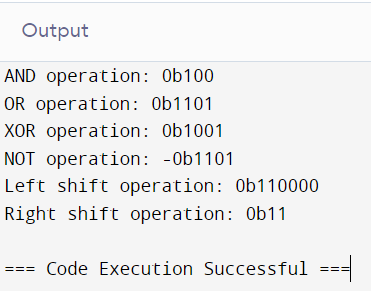Ever wondered how to manipulate the bits around in your code directly? Or, maybe you’re interested in how low-level operations work in Python. These are questions that pop up quite often when covering programming a bit more advanced.
Bitwise operators in Python provide operations at the bit level and are very powerful tools for special tasks where one needs efficient and exact control over binary data. We will delve deeper into the land of bitwise operators, showing how they could make our code more effective and efficient.
Detailed Explanation and Code Examples of Each Bitwise Operator
1. The Bitwise AND Operator (&)
The bitwise AND operator compares each bit of two integers and returns a new integer with bits set to 1 only when both corresponding bits are 1. This is often used in masking operations, especially wherever isolating specific bits is required within an integer.
Code Example
a = int(input("Enter the first integer: "))
b = int(input("Enter the second integer: "))
result = a & b
print("Bitwise AND result:", result)
Output:
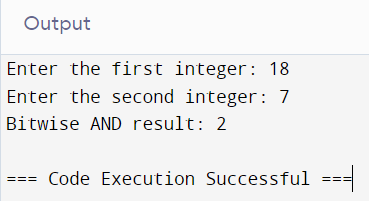
2. The Bitwise OR Operator (|)
The bitwise OR operator makes a bit-by-bit comparison between two integers and returns a new integer with bits set to 1 where at least one of the corresponding bits in comparison is 1. This is useful when we want to turn certain bits within an integer into 1 without affecting the other bits.
Code Example
a = int(input("Enter the first integer: "))
b = int(input("Enter the second integer: "))
result = a | b
print("Bitwise OR result:", result)
Output:
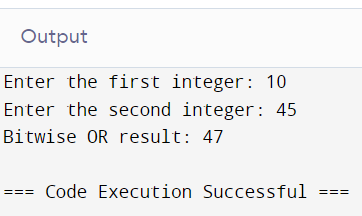
3. The Bitwise NOT Operator (~)
The bitwise NOT operator inverts all the bits in an integer: 1 changes to 0, and 0 changes to 1. This operator may be helpful in such operations that require flipping all the bits in a binary representation.
Code Example
a = int(input("Enter an integer: "))
result = ~a
print("Bitwise NOT result:", result)
Output:
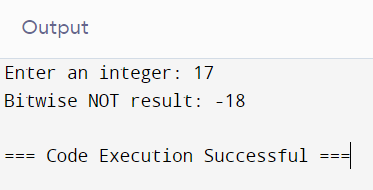
4. The Bitwise XOR Operator (^)
The bitwise XOR operator compares each of the corresponding bits of two integers and returns a new integer that has most of those bits set to 1 only when one of the corresponding bits is 1. This operator can be readily used to toggle certain bits within an integer.
Code Example
a = int(input("Enter the first integer: "))
b = int(input("Enter the second integer: "))
result = a ^ b
print("Bitwise XOR result:", result)
Output:
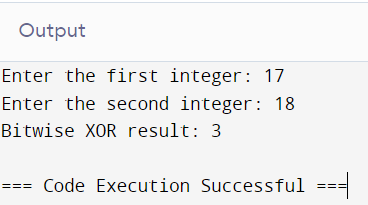
5. The Left Shift Operator (<<)
The left shift operator shifts the bits of an integer to the left by the specified number of positions, filling its rightmost bits with zeros. This operator is equivalent to multiplying the integer by 2, raised to the power of the number of positions shifted.
Code Example
a = int(input("Enter an integer: "))
shift = int(input("Enter the number of positions to shift left: "))
result = a << shift
print("Left Shift result:", result)
Output:
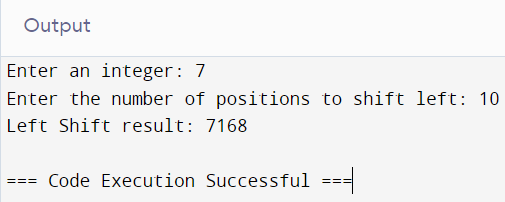
6. The Right Shift Operator (>>)
The right shift operator shifts the bits of an integer to the right by a specified number of positions, ordinarily discarding the rightmost; this is equivalent to integer division by 2 raised to the power of the positions shifted.
Code Example
a = int(input("Enter an integer: "))
shift = int(input("Enter the number of positions to shift right: "))
result = a >> shift
print("Right Shift result:", result)
Output:
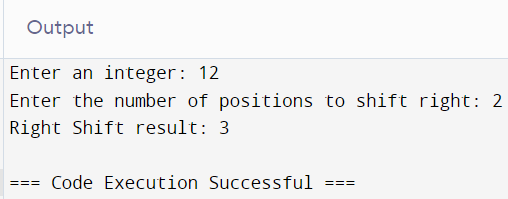

POSTGRADUATE PROGRAM IN
Multi Cloud Architecture & DevOps
Master cloud architecture, DevOps practices, and automation to build scalable, resilient systems.
Exploring Bitwise Operator Overloading in Python
Ever wondered if you could customise how bitwise operators in Python work with your objects? The good news is that we can do that in Python.
By using operator overloading, we can define how our custom classes behave with bitwise operators like &, |, ~, and ^.
How Does Operator Overloading Work?
Python allows us to redefine the behaviour of operators for user-defined classes.
We do this by defining special methods in our class.
For bitwise operators, the methods are:
- __and__ for &
- __or__ for |
- __xor__ for ^
- __invert__ for ~
- __lshift__ for <<
- __rshift__ for >>
Example: Custom Class with Bitwise Operator Overloading
Let’s create a class that represents a simple binary number and overloads the bitwise operators in Python.
class BinaryNumber:
def __init__(self, value):
self.value = value
def __and__(self, other):
return BinaryNumber(self.value & other.value)
def __or__(self, other):
return BinaryNumber(self.value | other.value)
def __xor__(self, other):
return BinaryNumber(self.value ^ other.value)
def __invert__(self):
return BinaryNumber(~self.value)
def __lshift__(self, other):
return BinaryNumber(self.value << other)
def __rshift__(self, other):
return BinaryNumber(self.value >> other)
def __str__(self):
return bin(self.value)
# Example usage
a = BinaryNumber(12)
b = BinaryNumber(5)
print("AND operation:", a & b)
print("OR operation:", a | b)
print("XOR operation:", a ^ b)
print("NOT operation:", ~a)
print("Left shift operation:", a << 2)
print("Right shift operation:", a >> 2)
Real-World Applications and Use Cases for Bitwise Operators
You might wonder, where do we actually use bitwise operators in real life? Bitwise operators in Python are incredibly useful in several areas.
Binary Data Manipulation
When dealing with file I/O, image processing, or cryptography, bitwise operations can help manipulate binary data efficiently.
Embedded Systems and Microcontrollers
In embedded systems, resources are limited. Bitwise operations allow for precise control over hardware peripherals and configuration registers.
Networking and IP Addressing
Network applications often involve IP address manipulation. Bitwise operators are essential for subnet masking and CIDR notation.
Graphics and Image Processing
In graphics, bitwise operations are used to manipulate pixel values, apply filters, and create visual effects.
Game Development
Game developers use bitwise operations for tasks like collision detection and game state management. These operations help optimise performance and enhance the visual appeal of games.
Conclusion
Bitwise operators in Python are strong features that let one work directly with binary data. Using such operators, we can further optimise our code to be more efficient by performing complex operations with much better speed.
Be it data manipulation, embedded systems, networking, graphics, or game development; bitwise operators become essential when one needs to exert fine-grained control or facilitate performance optimisation. Let’s continue exploring and leveraging these operators to take our programming skills to the next level.
What are Python's bitwise operators, and why are they key?
How does the bitwise AND operator work, and where can it be used?
Can Python's bitwise operators work with non-integral types?
What is the difference between the left shift (<<) and right shift (>>) operators?
How do we write an efficient use of bitwise operators—both in coding and performance optimisation aspects?
Updated on January 22, 2025

